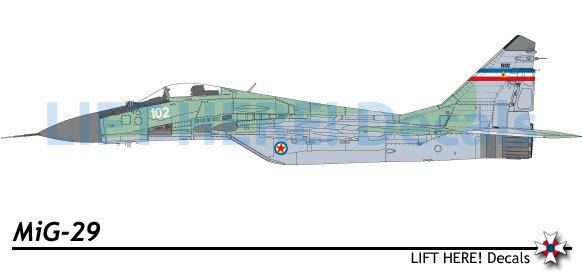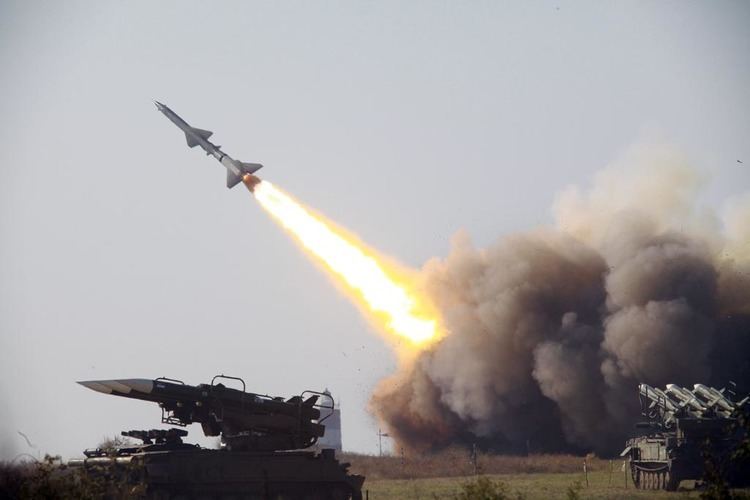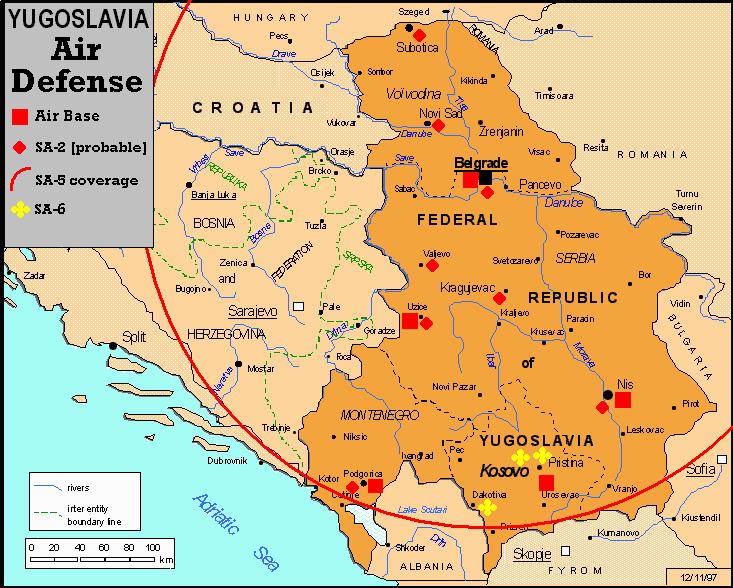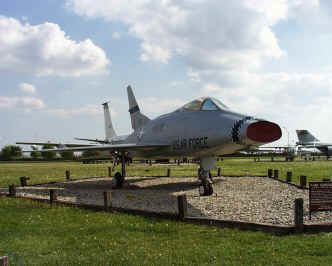Active 1912–19182006–present Size 5,100 personnel | Country Serbia Type Air Force Founded 2006 | |
 | ||
Motto "За слободу и част Отаџбине"; "For Freedom and Honor of the Fatherland" Similar Serbian Armed Forces, Yugoslav Air Force, Serbian Army, Croatian Air Force and Air D, Albanian Air Force | ||
The Serbian Air Force and Air Defence (Serbian: Ратно ваздухопловство и противваздухопловна одбрана / Ratno vazduhoplovstvo i protivvazduhoplovna odbrana), is the air force of Serbia and service branch of the Serbian Armed Forces. Established on 24 December 1912 in the city of Niš, it was absorbed into the various Yugoslav Air Forces between 1918 and 2006.
Contents
- Role
- Organization
- History of Freedom
- Balkan Wars
- World War I
- World War II
- NATO bombing of Yugoslavia
- Aircraft
- Air defence
- Radars
- Modernization 2011present
- Aircraft markings
- Serbian Air Force Centennial
- References

Role
Organization

History of Freedom

The first aviation pioneer in Serbia was Lieutenant Kosta Miletić (1874-1953), trained as a balloon pilot at the Technical Aeronautical School near Saint Petersburg, Russia from 27 February 1901 to 25 November 1902. Miletić was also trained in the use of carrier pigeons.

On the recommendation of Miletić, the Serbian armed forces posed messenger pigeon stations (in 1908 in Medosevac near Nis and in 1909 in Pirot), and bought two free spherical and one tied kite – balloon from the August Ridinger company from Augsburg. At the reception ceremony, on 19 April 1909, Kosta Miletić flew a spherical balloon called Srbija (Serbia). One balloon was provided from Russia. A gas chamber was ordered from the Dillmann company in Berlin, and a field winch from St Petersburg. A hydrogen unit was provided from the Swiss company Oerlikon. The equipment was delivered to Serbia in 1909 and 1910.

The first competition for cadet airmen in Serbia was opened in May 1911, and in the following year the first class of Serbian pilots started their flying training in France from 21 May to 8 September 1912 and got the rank of pilot. They finished the course in the beginning of the First Balkan War with aircraft and the balloons that had already been obtained prior to the outbreak of war. In the autumn of 1912, Serbia got the aircraft for its armed forces. On 24 December 1912 the head of the military ministry Radomir Putnik approved the formation of the Aviation Command situated in Niš; the commander was Major Kosta Miletić. It comprised: the Aircraft Squadron which counted 12 military aircraft, the Balloon Squad, the Pigeon Post and the Base. This date is regarded in Serbia as marking the official founding of the air force. This made Serbia one of the first 15 states in the world to have an air force.
Balkan Wars

The First Balkan War broke out in October 1912; Montenegro, Bulgaria, Greece, and Serbia waged it against the Ottoman Empire. In this war, the Serbian Aviation Command had its first combat experience. In February 1913, the High Command of Serbian Army formed an expeditionary Coastal Airplane Squadron in order to aid the Montenegrin ground force against Ottoman troops who were reinforced at the town of Skadar near the Adriatic coast. Air support for this formation was assigned to the newly established "Coastal Airplane Squad", the first Serbian air combat unit, with 4 airplanes (Blériot XI one-seater, Blériot XI two-seater, Deperdussin TT and Farman HF.20) and 5 pilots under the command of Major Kosta Miletić. In mid-March 1913, this combat air unit was relocated near the frontline at a newly built auxiliary airfield in the village of Barbalusi. The first reconnaissance flight was made on March 20 (March 7, oldstyle), by Lt. Zivojin Stanković and Sgt. Mihailo Petrović. In this combat-reconnaissance flight on his Farman HF. 20 over the Skadar Front on 20 March 1913, Sgt. Mihailo Petrović was killed, thus becoming the first casualty in the history of the Serbian military aviation and the second one in world aviation history. Mihajlo Petrović was the first trained Serbian airplane pilot. He completed his training and exams at the famous Farman pilot school in France and was awarded the international FAI license no. 979 in June 1912. His Serbian pilot's license carries the number 1. The next day, pilots Lt. Zivojin Stankovich and Sgt. Miodrag Tomich successfully completed their first reconnaissance flights, and in the following days, pilots Milos Ilic, Stankovich and Tomich dropped a number of small bombs and conducted reconnaissance flights. A fascinating fact represents that the pilot Tomich and Esad Pasha, the former Turkish commander at the Skadar frontline, would meet in a completely different situation two years later, during the First World War, when pilot Tomich needed help.
After Bulgaria attacked at Bregalnica in Serbia, the Second Balkan War began. The first reconnaissance mission had been performed by Miodrag Tomić, and after that Tomić and Stanković took turns and during a period of a month and a half, as the war with Bulgarians lasted, the two airmen performed 21 reconnaissance missions, of which Tomić did 14 flights. During one flight above Kriva Palanka, Tomić encountered a Bulgarian plane in the air, but neither one had weapons and they just greeted one another by hand waving.
World War I
General mobilization in the summer of 1914 found the Serbian Aeroplane Escadre not well prepared. The Aeroplane Escadre had only 9 aeroplanes of which 7 were in flying condition. Five planes and three pilots were relocated to the auxiliary airfield at Dabića. From that airfield, Captain's Živojin Stanković and 2nd Lieutenant Miodrag Tomić on August 13, 1914 commenced their first reconnaissance flights in the Great War. Tomić took off from the airfield at Jevremovac on August 27, at five o’clock in the afternoon. Above Mishar he encountered an enemy plane and they were quite close to each other. The enemy plane opened fire on Tomić, who did not expect this, but he avoided it with an appropriate and fast maneuver, so the plane did not sustain any hits. Fire was coming from a Parabellum. It was – probably – the first exchange of fire between aircraft in history. Because of air supremacy of the K.u.K. Luftfahrtruppen over the Serbian Front, in March 1915 the French Escadrille arrived (Escadrille MF 99 S) under command of Captain Roger Vitrat to aid the weakness of the Serbian Aeroplane Escadre. The French Escadrille held the frontline from Smederevo to Loznica, and the Serbian Escadre from Smederevo to Golubac. After the conquest of Serbia by the Central Powers in the autumn of 1915 and the great retreat of the Serbian army to the island of Corfu, the Salonica Front was formed. During the invasion on Serbia in October 1915, Manfred von Richthofen was commenced its first combat flight as a pilot. Also, in the autumn of 1915, the first medical transport of the wounded and sick in world aviation history was realized in Serbia. One of the ill soldiers in that first medical transport was Milan Stefanik, a Czechoslovakian pilot-volunteer. In June 1916 the reconstituted Serbian army sailed from Corfu and joined the French and British at Salonika. At the Salonica Front line, with the support of the Allied force, the Serbian Aeroplane Escadre was reorganized. From mid-1916 to 1918 at the Serbian part of the new established frontline, 5 Escadrilles (N521, N522, N523, N524 and N525) were operated, and squadrons were staffed with most of French and Serbian personnel. These air force units were officially known as the Aéronautique de l’Armée Serbe or Serbian Army Air Service and were attached to the High Command of Serbian Army which was a part of Allied Macedonian Army or Armée de l'Orient. It was commanded by a French officer, Major Roger Vitrat. In the beginning of 1918 the new reorganisation was started when the 1st Serbian Escadrille was formed on January 17, and the 2nd Serbian Escadrille on May 1, 1918, staffed with Serbian personnel.
World War II
The attacking forces engaged in the April War (6 to 17 April) were 2373 aircraft strong, including 1212 aircraft from Germany, 647 from Italy and 287 from Hungary, while the Royal Yugoslav Air Force had 494 airplanes, only 269 of a modern type. Thus the ratio in the beginning of operations was 5:1 in favor of the enemy, and if we count only modern Yugoslav aircraft the ratio climbs to 7:1 in favor of the Axis powers. In spite of huge logistic difficulties and acts of treason (proclamation of the so-called "Independent State of Croatia" on April 10, 1941) the Royal Yugoslav Air Force fulfilled its duties with honor. Yugoslav airmen fought with incomparable courage against an enemy superior both technically and numerically. Especially, the 5th and 6th Fighter Wing pilots showed their bravery. During the war operations (6 to 15 April) a total of 1416 take-offs was made, 993 of which were performed by fighters and 423 by bombers. During this short war 135 flight crew members and 576 ground personnel bravely lost their lives. About 300 Yugoslav Air Force personnel escaped, first to Greece then to Crete. After the Battle of Crete they went on to the deserts of the Near and Middle East, where for a short time they found a safe place. Meanwhile, Field Marshal Erwin Rommel had already arrived with his Afrika Korps. In June 1941 the 20th Hydroaviation Escadrille under command of Lt Vladeta Petrovich with their no surrender war flag was renamed in the 2nd Yugoslav Squadron, attached to No. 230 Squadron RAF.
NATO bombing of Yugoslavia
An important portion of the 1999 war between Yugoslavia and the NATO coalition involved combat between the Yugoslav Air Force, which was the predecessor of today's Serbian Air Force, and the opposing air forces of NATO. United States Air Force F-15s and F-16s flying mainly from Italian air force bases attacked the defending Yugoslav fighters—usually MiG-29s, which were in bad shape, due to lack of spare parts and maintenance. A total of six Yugoslav MiG-29s were shot down in 1999, of which three were shot down by USAF F-15s, one by a USAF F-16, and one by a RNAF F-16. One aircraft, according to a Serbian documentary, was hit by friendly fire from the ground. Another four were destroyed on the ground. During the course of the air war, Yugoslav anti-aircraft defenses downed a USAF F-16C and an F-117 Nighthawk, the first stealth aircraft ever to be shot down in combat.
Aircraft
The air force fleet consists of several Soviet combat aircraft, consisting of a number of MiG-21s, and MiG-29s. Serbia is looking to replace its aging fleet with new multi-role combat aircraft. Before its demise, the former Yugoslav Air Force was developing the Novi Avion project which was intended as a replacement. The project was canceled in 1991 due to the collapse of Yugoslavia.
Serbia, as the largest succeeding nation of Yugoslavia, took possession of the entire Yugoslav Air Force inventory. After the Agreement on Sub-Regional Arms Control was enacted in 1996, dozens of J-22, J-21 and G-2s have been withdrawn from service.
The air force operates from three major air bases, the 204th Batajnica Air Base and 98th Lađevci Air Base and Niš Air Base.
Air defence
The Serbian air force operates a variety of Soviet surface-to-air missile systems. Many are long-range with a moderate amount of short-range weapons assigned to infantry units. The 250th Air Defence Missile Brigade operates SA-3 and SA-6 surface-to-air missile systems. The military is upgrading both types with fire-and-forget ability. The air force has upgraded "Neva-M" to the "Neva-M1T" standard and "Kub-M" to "Kub-M2". For defending air bases and important infrastructures Bofors 40mm L-70 in complement with M-85 Zirafa radars are used, and for engaging low flight targets 9K38 Igla or SA-18.
SA-6 were upgraded also with improved R-60 (missile) and R-73 (missile). Those Air-To-Air missiles are added on the existing SA-6 system.
Radars
The inventory includes Marconi S-600 series radars: model S-605/654 Observation radars, and model S-613 Altitude measurement radar; AN/TPS-70 3D radar; AS-74 and AS-84 automatized systems. There are AN/TPS-63 radars out of service.
Modernization (2011–present)
The Serbian Ministry of Defence intended the purchase of new multirole combat aircraft to replace its aging fleet of MiG-21 and MiG-29 combat aircraft. Reports in the media in December 2011 speculated between 12 and 16 aircraft would be ordered and listed the F-16, F-18, Rafale, JAS 39 Gripen, Eurofighter Typhoon, Su-30 or the MiG-29M as possible candidates.
Military analyst Miroslav Lazanski claimed Russia is offering Serbia 12 MiG-29M/M2 combat aircraft along with S-300PMU-2 and Pantsir-S1 surface-to-air missile systems, as well as two radars for its air defence. In June 2013, defence minister Aleksandar Vučić suggested that Serbia might purchase six MiG-29M/M2s.
In July 2013, media reports suggested that Serbia might be interested in purchasing a squadron of medium transport helicopters, preferably the Mi-17.
In the summer of 2014, Serbia abandoned its plans to purchase new MiGs from Russia or any other new aircraft in order to put aside 24 million dinars for the overhaul of G-4 supergalebs. This decision depended on the level of scientific-technological knowledge and financial capacity of the state. In January 2016, after Croatia's plans to purchase MGM-140 ATACMS tactical missiles from the U.S., Serbia sent requests to purchase Tor, Pantsir, and Buk air defense systems as well as MiG-29 jet fighters. In November 2016, six MiG-29 are ready to be delivered to Serbia, if repair costs are covered (reportedly $50 million). In December 2016, the agreement of shipment of six MiG-29 aircraft has been sealed and they are expected to arrive by March 2017, and all 10 of Serbia's MiG29 will be modernized to the MiG-29SM standard. Also, Serbia's defence minister Zoran Dordevic announced that Belarus will donate 8 old Mig-29 and 2 Buk missile systems to Serbia on conditions that Serbia pays for the repairs.
Aircraft markings
The Serbian Air Force roundel was officially adopted in 2006. The roundel is an adapted version of the former Royal Yugoslav Air Force roundel which ceased to exist in 1943. It is composed of a blue trim on the outside rim followed inward by the Serbian national colours red, blue and white, with a white cross in the centre with blue trim.
The Air Force also uses a low visibility roundel of the same design only replacing the traditional roundel colours of red, blue and white with two grey colour variations of light and dark for contrast; these roundels have most recently been placed on refurbished MiG-29s. Most other aircraft continue to use the standard coloured roundel.
Serbian Air Force Centennial
The Serbian Air Force observed its centennial anniversary celebration on 2 September 2012, marking one hundred years of its existence by hosting an international air show organized by the Ministry of Defense as the central manifestation. The air show featured representatives from 16 countries around the world and 27 kinds of aircraft.
